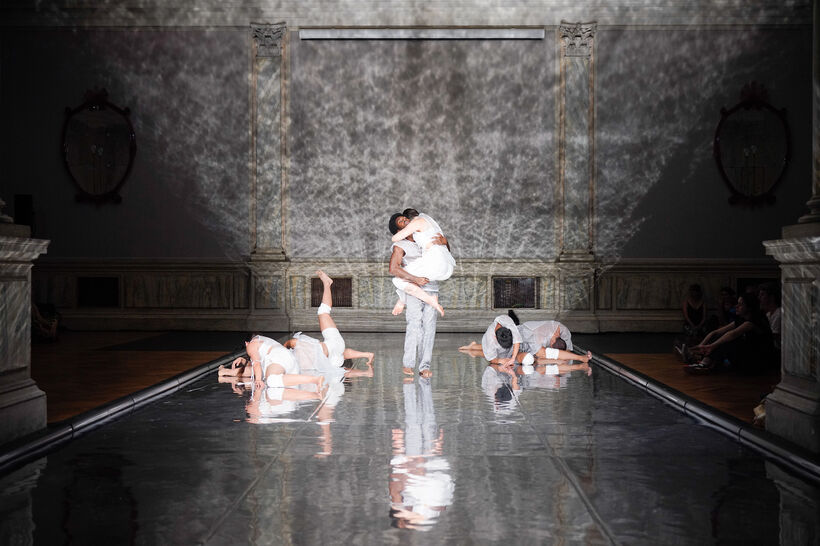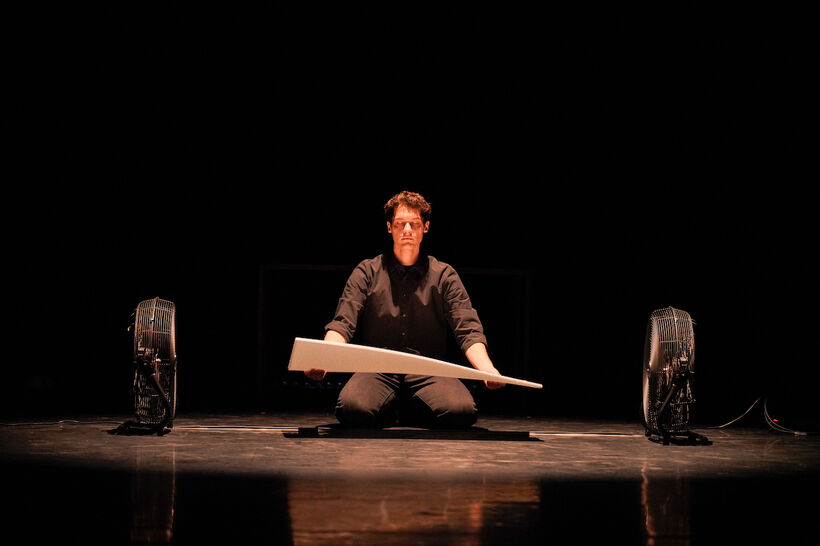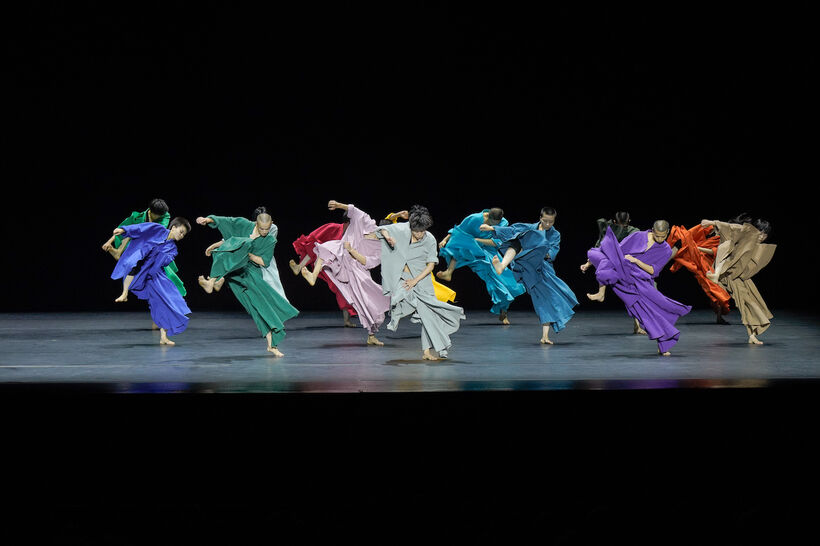Biennale Danza - Altered States in Venice #2
After experiencing the first couple of days, I returned to catch some glimpses from the third and final week of the festival, including the powerful TAO Dance Theatre, recently awarded the 2023 Silver Lion, Biennale College Choreographers’ well put together pieces, and the choreography for objects by Andrea Salustri.
Over the years, Biennale Danza has invested in the advanced training of dancers and choreographers, starting with the editions curated by Carolyn Carlson with the creation of Accademia Isola Danza, and with Ismael Ivo's Arsenale della Danza. The current Biennale College Danza (Dancers and Choreographers) is continuing, in different but parallel ways, in the same vein.
Mosaic and Ténèbres Vacillantes are the choreographic outcomes of the studies of the two young choreographers selected, Scott Elstermann and Hai-Wen Hsu.
Eight dancers from the Biennale College Dance group, dressed in gold and silver overalls, are the protagonists of Elstermann’s Mosaic. The piece begins with the full ensemble forming a large embrace that then opens outwards, as if the dance could start simply through their proximity to each other. Duets and solos follow one another in a puppet style, like an exercise in manipulation. The dance becomes a code dance, culminating in a techno-inspired moment, which I personally did not think completely worked, since it was perhaps too aesthetic rather than heartfelt. It was towards the end that, surprisingly, they raised the dance linoleum floor: a reflective gold platform appeared underneath, illuminating their costumed bodies and giving the dance an uplifting spirit that reconnects the work to its pure beginnings.
Hsu's Ténèbres Vacillantes sees the other eight dancers dressed in white shorts and grey blouses with knee pads, engaged in complex choreographic work often overlaid with video projections. The choreography is mainly developed through an in-depth stage perspective, following a path bordered by neon lights. What has stayed with me from this piece is the almost martial movement vocabulary, combined with a strong, overpowering feminine energy.
In both pieces, the lighting by experienced lighting designer Fabio Bozzetta stood out.
Materia by the Berlin-based Italian Andrea Salustri is the second creation by an Italian artist to feature at the festival. Materia is a piece of choreography for one human performer (Salustri himself on stage) and polystyrene, which aims to broaden perception through object-based practices. With just a few elements, such as fans and polystyrene in various forms, and with techniques influenced by street art, circus, and contemporary dance, Salustri certainly has the ability to create visual and audio images which are in dialogue with our perception and memories. Moreover, the artistic thinking behind his research for Materia, namely how to use disposable objects and challenging their function, succeeds in activating an effective and imaginative process of object defamiliarisation and of the reacquisition of new meaning. In addition, his presence is completely calibrated, delicate, and in deep relationship with the scenic process. However, I found the piece dramaturgically disconnected, that is, it travels from picture to picture, as if they were several detached numbers. While this works visually and sonorously, the lack of cohesion in the piece's dramaturgy weakened its final impact.
The festival came to an end, both for me and altogether, with 13 and 14 of the Series of Number by the Silver Lion-winner TAO Dance Theatre.
TAO Dance Theatre, founded in 2008 in Beijing by choreographers Tao Ye, Duan Ni and producer Wang Hao, uses a movement technique called the 'Circular Movement System'. At its core is the idea of pure dance, achieved through the 'ritualistic repetition of the body's natural movements'.
13 and 14 feature thirteen and fourteen dancers respectively. 13 is a minimalist creation, set in a white, completely empty set. I was very impressed that, during the first part, the dancers moved together with their eyes closed, listening to each other in a highly perceptive manner. It appeared at first that there were only a few dancers, until gradually more and more were revealed to us. They were dressed in very loose clothing in various shades of grey, almost à la the Japanese fashion brand Comme des Garçons. The group then broke up to create duets and trios with incidental takes and very fast movements.
Following a soundscape based on a clock continuing its non-stop rhythm, 14 sees the company dressed in large, colourful outfits, always remaining in the same formation, constantly repeating circular movement patterns whilst also subtly developing and evolving them. Although they move together, like one large organism united by a single breath, the individual dancing personas emerge in a delicate but incisive manner.
In both pieces, the choreography is magnetic, featuring martial-arts, including, perhaps, Shaolin influences infused with American and European floor techniques. Nevertheless, the rigour of the choreographic composition and staging makes one think of China’s current social-historical context. In particular, 13 recalls the dehumanisation of bodies and personalities in labour camps.
A Goodbye to Venice
The festival gave each invited artist the freedom to bring personal poetics and aesthetics onto the stage, and the opportunity to use unique language to address urgent and current issues, such as the environment, queerness, post-colonialism.
On the other hand, the programme continued a trend from previous Biennale Danza festivals, which is the drastic lack of Italian dance. Although there were two Italian artists on the bill (Luna Cenere, and the Berlin-based Andrea Salustri), the issue certainly persists, demonstrating a curatorial disconnect with the Italian territory. Clearly, Biennale Danza is bringing international dance companies to Venice and must continue to do so, but specific attention to the context in which the festival is set would, in my opinion, benefit the value of the programming itself as an investigator of the current dance ecosystem of the host location. Here, I cannot help but think of the memorable Biennale Danza editions curated by Virgilio Sieni, who managed to keep both an international and local focus with masterful fieldwork.
Moreover, it would be interesting to understand the perspective that artistic director McGregor and his team could bring in scouting the many perspectives that the Italian dance scene offers, and bring them to Venice. Thanks to the economic means, the strong organisational structure, and the team’s artistic vision, I believe that Biennale Danza's next step should be to act as a true catalyzer of forces: remaining international whilst being open to national dance discourses, creating policies of new glocal relationships.
Altered States proved to be an intense polyphonic festival, unquestionably well-articulated and well-coordinated. Often at the end of the performances I saw that the audience was united in warm applause. I am now truly looking forward to the next edition, where I hope there will also be a little more space for Italian dance artists.
Written from Altered States Biennale Danza International Festival of Contemporary Dance from the 13th to the 29th July 2023, in Venice, Italy.






